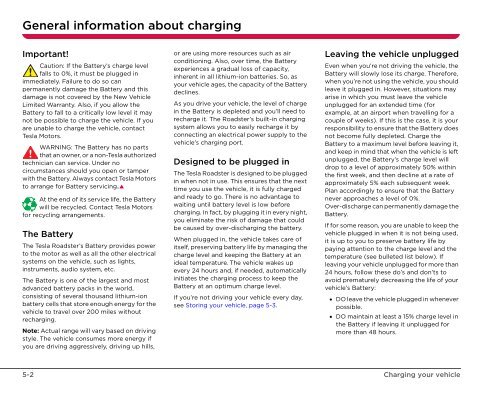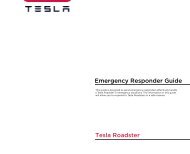You also want an ePaper? Increase the reach of your titles
YUMPU automatically turns print PDFs into web optimized ePapers that Google loves.
General information about charging<br />
Charging General information your vehicle about charging<br />
Important!<br />
Caution: If the Battery’s charge level<br />
falls to 0%, it must be plugged in<br />
immediately. Failure to do so can<br />
permanently damage the Battery and this<br />
damage is not covered by the New Vehicle<br />
Limited Warranty. Also, if you allow the<br />
Battery to fall to a critically low level it may<br />
not be possible to charge the vehicle. If you<br />
are unable to charge the vehicle, contact<br />
Tesla Motors.<br />
WARNING: The Battery has no parts<br />
that an owner, or a non-Tesla authorized<br />
technician can service. Under no<br />
circumstances should you open or tamper<br />
with the Battery. Always contact Tesla Motors<br />
to arrange for Battery servicing.<br />
At the end of its service life, the Battery<br />
will be recycled. Contact Tesla Motors<br />
for recycling arrangements.<br />
The Battery<br />
The Tesla Roadster’s Battery provides power<br />
to the motor as well as all the other electrical<br />
systems on the vehicle, such as lights,<br />
instruments, audio system, etc.<br />
The Battery is one of the largest and most<br />
advanced battery packs in the world,<br />
consisting of several thousand lithium-ion<br />
battery cells that store enough energy for the<br />
vehicle to travel over 200 miles without<br />
recharging.<br />
Note: Actual range will vary based on driving<br />
style. The vehicle consumes more energy if<br />
you are driving aggressively, driving up hills,<br />
or are using more resources such as air<br />
conditioning. Also, over time, the Battery<br />
experiences a gradual loss of capacity,<br />
inherent in all lithium-ion batteries. So, as<br />
your vehicle ages, the capacity of the Battery<br />
declines.<br />
As you drive your vehicle, the level of charge<br />
in the Battery is depleted and you’ll need to<br />
recharge it. The Roadster’s built-in charging<br />
system allows you to easily recharge it by<br />
connecting an electrical power supply to the<br />
vehicle’s charging port.<br />
Designed to be plugged in<br />
The Tesla Roadster is designed to be plugged<br />
in when not in use. This ensures that the next<br />
time you use the vehicle, it is fully charged<br />
and ready to go. There is no advantage to<br />
waiting until battery level is low before<br />
charging. In fact, by plugging it in every night,<br />
you eliminate the risk of damage that could<br />
be caused by over-discharging the battery.<br />
When plugged in, the vehicle takes care of<br />
itself, preserving battery life by managing the<br />
charge level and keeping the Battery at an<br />
ideal temperature. The vehicle wakes up<br />
every 24 hours and, if needed, automatically<br />
initiates the charging process to keep the<br />
Battery at an optimum charge level.<br />
If you’re not driving your vehicle every day,<br />
see Storing your vehicle, page 5-3.<br />
Leaving the vehicle unplugged<br />
Even when you’re not driving the vehicle, the<br />
Battery will slowly lose its charge. Therefore,<br />
when you’re not using the vehicle, you should<br />
leave it plugged in. However, situations may<br />
arise in which you must leave the vehicle<br />
unplugged for an extended time (for<br />
example, at an airport when travelling for a<br />
couple of weeks). If this is the case, it is your<br />
responsibility to ensure that the Battery does<br />
not become fully depleted. Charge the<br />
Battery to a maximum level before leaving it,<br />
and keep in mind that when the vehicle is left<br />
unplugged, the Battery’s charge level will<br />
drop to a level of approximately 50% within<br />
the first week, and then decline at a rate of<br />
approximately 5% each subsequent week.<br />
Plan accordingly to ensure that the Battery<br />
never approaches a level of 0%.<br />
Over-discharge can permanently damage the<br />
Battery.<br />
If for some reason, you are unable to keep the<br />
vehicle plugged in when it is not being used,<br />
it is up to you to preserve battery life by<br />
paying attention to the charge level and the<br />
temperature (see bulleted list below). If<br />
leaving your vehicle unplugged for more than<br />
24 hours, follow these do’s and don’ts to<br />
avoid prematurely decreasing the life of your<br />
vehicle’s Battery:<br />
• DO leave the vehicle plugged in whenever<br />
possible.<br />
• DO maintain at least a 15% charge level in<br />
the Battery if leaving it unplugged for<br />
more than 48 hours.<br />
5-2 Charging your vehicle







